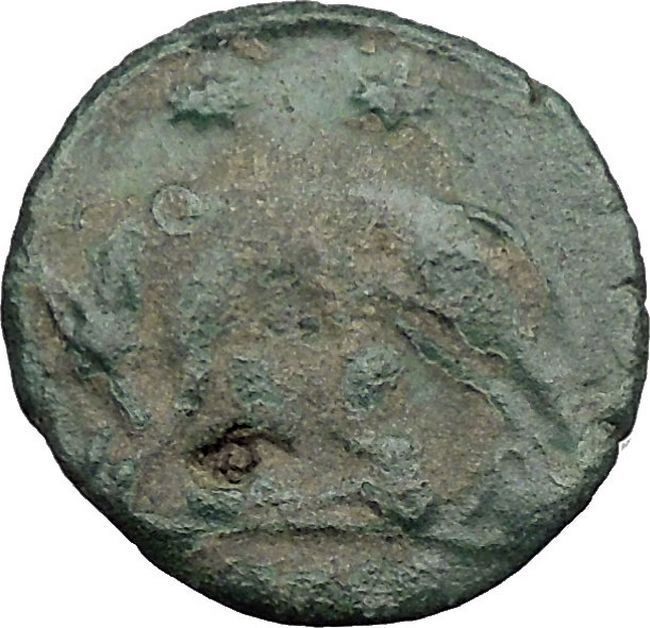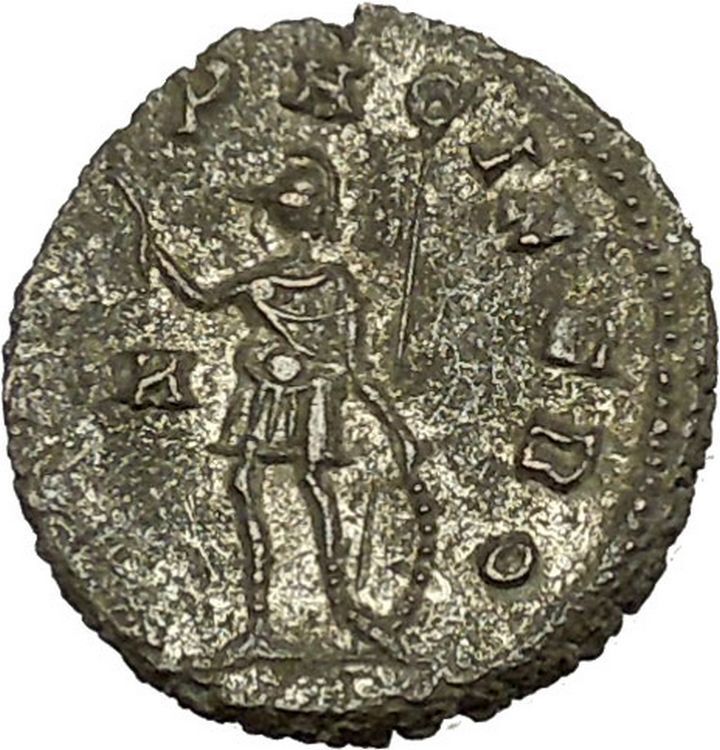|
Honorius – Roman Emperor: 393-423 A.D.
Bronze AE4 11mm (0.97 grams) Struck circa 395-401 A.D.
DNHONORIVSPFAVG – Diademed, draped and cuirassed bust right.
SALVSREIPVBLICAE – Victory advancing left, holding trophy
and dragging captive.
You are bidding on the exact item pictured,
provided with a Certificate of Authenticity and Lifetime Guarantee of
Authenticity.

Flavius Honorius ( 9 September 384 – 15 August 423 )
was Roman Emperor
(393–395) and then
Western Roman Emperor
from 395 until his death. He was the younger son of
Theodosius I
and his first wife
Aelia Flaccilla
, and brother of the Eastern Emperor
Arcadius
.
Even by the standards of the rapidly declining Western
Empire, Honorius’ reign was precarious and chaotic. His throne was guarded by
his principal general, Flavius
Stilicho
,
who was successively Honorius’s guardian (during his childhood) and his
father-in-law (after the emperor became an adult). Stilicho’s generalship helped
preserve some level of stability, but with his execution, the Western Roman
Empire moved closer to collapse.
//
Rule
Early reign
After holding the
consulate
at
the age of two, Honorius was declared
Augustus
, and thus co-ruler, on
23 January
393 after the
death of
Valentinian II
and the usurpation of
Eugenius
.
When Theodosius died, in January 395, Honorius and Arcadius divided the Empire,
so that Honorius became Western Roman Emperor at the age of ten.
During the first part of his reign Honorius depended on the
military leadership of the general Stilicho, who was of mixed
Vandal
and Roman ancestry. To strengthen his bonds with the young emperor,
Stilicho married his daughter
Maria
to him. The
epithalamion
written for the occasion by Stilicho’s court poet
Claudian
survives.
At first Honorius based his capital in
Mediolanum
,
but when the Visigoths
entered Italy in 402 he moved his capital to the coastal city of
Ravenna
,
which was protected by a ring of marshes and strong fortifications. While the
new capital was easier to defend, it was poorly situated to allow Roman forces
to protect central Italy from the increasingly regular threat of barbarian
incursions.
Erosion of
the Western Roman Empire
Honorius’ reign was plagued by many threats: from the
barbarians entering within the Empire’s borders to several usurpers.
A
revolt led by Gildo
, comes Africae, in Northern Africa lasted for two
years (397-398). In 405, a barbarian army led by
Radagaisus
invaded
Italy
, bringing devastation to the heart of the Empire, until Stilicho
defeated them in 406.
The situation in
Britannia
was even more problematic. The British provinces were isolated, lacking support
from the Empire, and the soldiers supported the revolts of
Marcus
(406 – 407),
Gratian
(407), and
Constantine “III”
. Constantine invaded Gaul in 407, occupying
Arles
.
An invasion of
Alans
,
Suevi
and
Vandals
moved from Gaul on
31
December
406, and arrived in
Hispania
in
409. In 408, Stilicho (after forcing the Roman Senate to pay 4,000 pounds of
gold)
was arrested and executed by the order of Honorius, probably because of a court
conspiracy against the
Arian
general. The Visigoths under their King
Alaric I
invaded Italy in 408, besieged Rome, and extorted from the city a ransom of
5,000 pounds of gold, 30,000 pounds of silver, 4,000 silken tunics, 3,000 hides
dyed scarlet, and 3,000 pounds of pepper),
while Honorius in Ravenna did nothing.
In 409, Alaric returned, and with the agreement of the Senate
supported the usurpation of
Priscus Attalus
. In 410, the
Eastern Roman Empire
sent six
Legions
(6,000 men; late Roman legions were small units)
to aid Honorius. To counter Priscus, Honorius tried to negotiate with Alaric.
Alaric withdrew his support for Priscus in 410, but the negotiations with
Honorius broke down. Alaric again entered Italy and
sacked Rome
.
The revolt of Constantine III in the west continued through
this period. In 409,
Gerontius
, Constantine III’s general in Hispania, rebelled against him,
proclaimed
Maximus
Emperor, and besieged Constantine at Arles. Honorius now found
himself an able commander,
Constantius
, who defeated Maximus and Gerontius, and then Constantine, in
411.
Gaul was again a source of troubles for Honorius: just after
Constantius’ troops had returned to Italy,
Jovinus
revolted in northern Gaul, with the support of Alans, Burgundians, and the
Gallic nobility. Jovinus tried to negotiate with the invading
Goths
of Ataulf
(412), but his proclamation of his brother
Sebastianus
as
Augustus
made Ataulf seek alliance with Honorius. Honorius had Ataulf settle
the matter with Jovinus, and the rebel was defeated and executed in 413.
In 414, Constantius attacked Ataulf, who proclaimed Priscus
Attalus emperor again. Constantius drove Ataulf into Hispania, and Attalus,
having again lost Visigoth support, was captured and deposed.
Northeastern Gaul became subject to even greater
Frankish
influence, while a treaty signed in 418 granted to the
Visigoths
the southwestern portion, the former
Gallia Aquitania
.
In 417, Constantius married Honorius’ sister,
Galla Placidia
. In 421, Honorius recognized him as co-emperor Constantius
III, but he died early in 422.
In 420-422, another Maximus (or perhaps the same) gained and
lost power in Hispania.
Death
Honorius died of
dropsy
in 423, leaving no heir. In the subsequent interregnum
Joannes
was
nominated emperor. The following year, however, the Eastern Emperor
Theodosius II
elected emperor his cousin
Valentinian III
, son of
Galla Placidia
and
Constantius III
.
Sack of Rome

The Favorites of the Emperor Honorius, by
John William Waterhouse
, 1883.
The most notable event of his reign was the assault and
Sack of Rome
on
August 24
,
410 by the
Visigoths under Alaric
.
The city had been under Visigothic siege since shortly after
Stilicho’s deposition and execution in the summer of 408. Lacking a strong
general to control the by-now mostly barbarian Roman Army, Honorius could do
little to attack Alaric’s forces directly, and apparently adopted the only
strategy he could in the situation: wait passively for the Visigoths to grow
weary and spend the time marshalling what forces he could. Unfortunately, this
course of action appeared to be the product of Honorius’ indecisive character
and he suffered much criticism for it both from contemporaries and later
historians.
Whether this plan could have worked is perhaps debatable. In
any case it was overtaken by events. Stricken by starvation, somebody opened
Rome’s defenses to Alaric and the Goths poured in. The city had not been under
the control of a foreign force since an invasion of Gauls some eight centuries
before. The sack itself was notably mild as sacks go; Churches and religious
statuary went unharmed for example. The psychological blow to the Romans was
considerably more painful. The shock of this event reverberated from Britain to
Jerusalem, and inspired
Augustine
to write his magnum opus,
The City of God
.
The year 410 also saw Honorius reply to a
British
plea for assistance against local barbarian incursions. Preoccupied
with the Visigoths, Honorius lacked any military capability to assist the
distant province. According to
Zosimus
, “Honorius
wrote letters to the cities in Britain, bidding them to guard themselves.”
Judgments on Honorius

19th century engraving of Honorius, derived from his
coinage
In his History of the Wars,
Procopius
mentions a story (which
Gibbon
disbelieved) where, on hearing the news that Rome had “perished”,
Honorius was initially shocked; thinking the news was in reference to a favorite
chicken
he
had named “Roma”, he recalled in disbelief that the bird was just recently
feeding out of his hand. It was then explained to him that the Rome in question
was the city.
Summarizing his account of Honorius’ reign, the historian
J.B. Bury
wrote, “His name would be forgotten among the obscurest occupants
of the Imperial throne were it not that his reign coincided with the fatal
period in which it was decided that western Europe was to pass from the Roman to
the Teuton.” After listing the disasters of those 28 years, Bury concludes that
Honorius “himself did nothing of note against the enemies who infested his
realm, but personally he was extraordinarily fortunate in occupying the throne
till he died a natural death and witnessing the destruction of the multitude of
tyrants who rose up against him.”
Honorius issued a decree during his reign, prohibiting men
from wearing trousers in Rome [Codex Theodosianus 14.10.2-3, tr. C. Pharr, “The
Theodosian Code,” p. 415]. The last known gladiatorial fight took place during
the reign of Honorius.
In
Greek mythology
,
Nike
was a goddess
who personified
victory
, also known as the Winged Goddess of
Victory. The Roman equivalent was
Victoria
. Depending upon the time of various
myths, she was described as the daughter of
Pallas
(Titan) and
Styx (Water) and the sister of
Kratos
(Strength),
Bia
(Force), and
Zelus
(Zeal). Nike and her siblings were close
companions of Zeus
, the dominant deity of the
Greek pantheon
. According to classical (later)
myth, Styx brought them to Zeus when

the
god was assembling allies for the
Titan War
against the older deities. Nike
assumed the role of the divine
charioteer
, a role in which she often is
portrayed in Classical Greek art. Nike flew around battlefields rewarding the
victors with glory and fame.
Nike is seen with wings in most statues and paintings. Most other winged
deities in the Greek pantheon had shed their wings by Classical times. Nike is
the goddess of strength, speed, and victory. Nike was a very close acquaintance
of Athena
, and is thought to have stood in
Athena’s outstretched hand in the statue of Athena located in the Parthenon.
Nike is one of the most commonly portrayed figures on Greek coins.
Names stemming from Nike include amongst others:
Nicholas
, Nicola, Nick, Nikolai, Nils, Klaas,
Nicole, Ike, Niki, Nikita, Nika, Niketas, and Nico.
In
Roman mythology
, Victoria was the personification/Goddess of victory.
She is the Roman version of the
Greek goddess
Nike
, and was associated with
Bellona
. She was adapted from the
Sabine
agricultural goddess
Vacuna
and had
a
temple
on the
Palatine Hill
. Her name (in Latin) means victory. Unlike the Greek Nike, Victoria (Latin
for “victory”) was a major part of Roman society. Multiple temples were erected
in her honour. When her statue was removed in 382 AD by emperor
Gratianus
there was much anger in Rome. She was normally worshipped by
triumphant
generals returning from war. Also unlike the Greek Nike, who was known for success in athletic games such
as chariot races, Victoria was a symbol of victory over death and determined who
would be successful during war. Appearing on Roman coins, jewelry, architecture, and other arts, Victoria is
often seen with or in a
chariot
. An
example of this is her place upon the
Brandenburg Gate
in Berlin, Germany.
|












